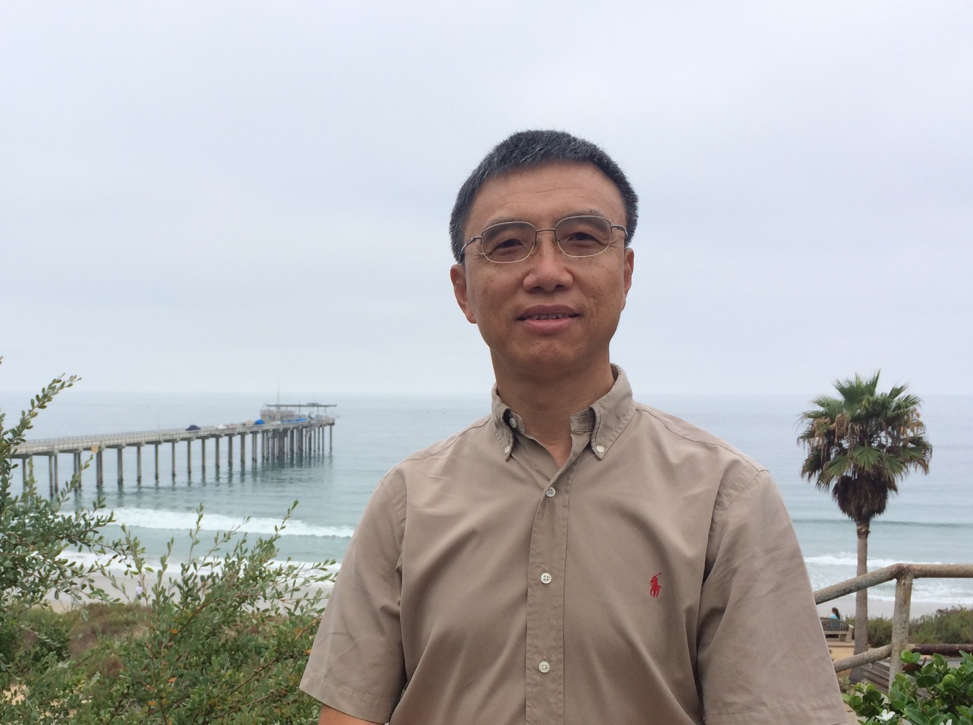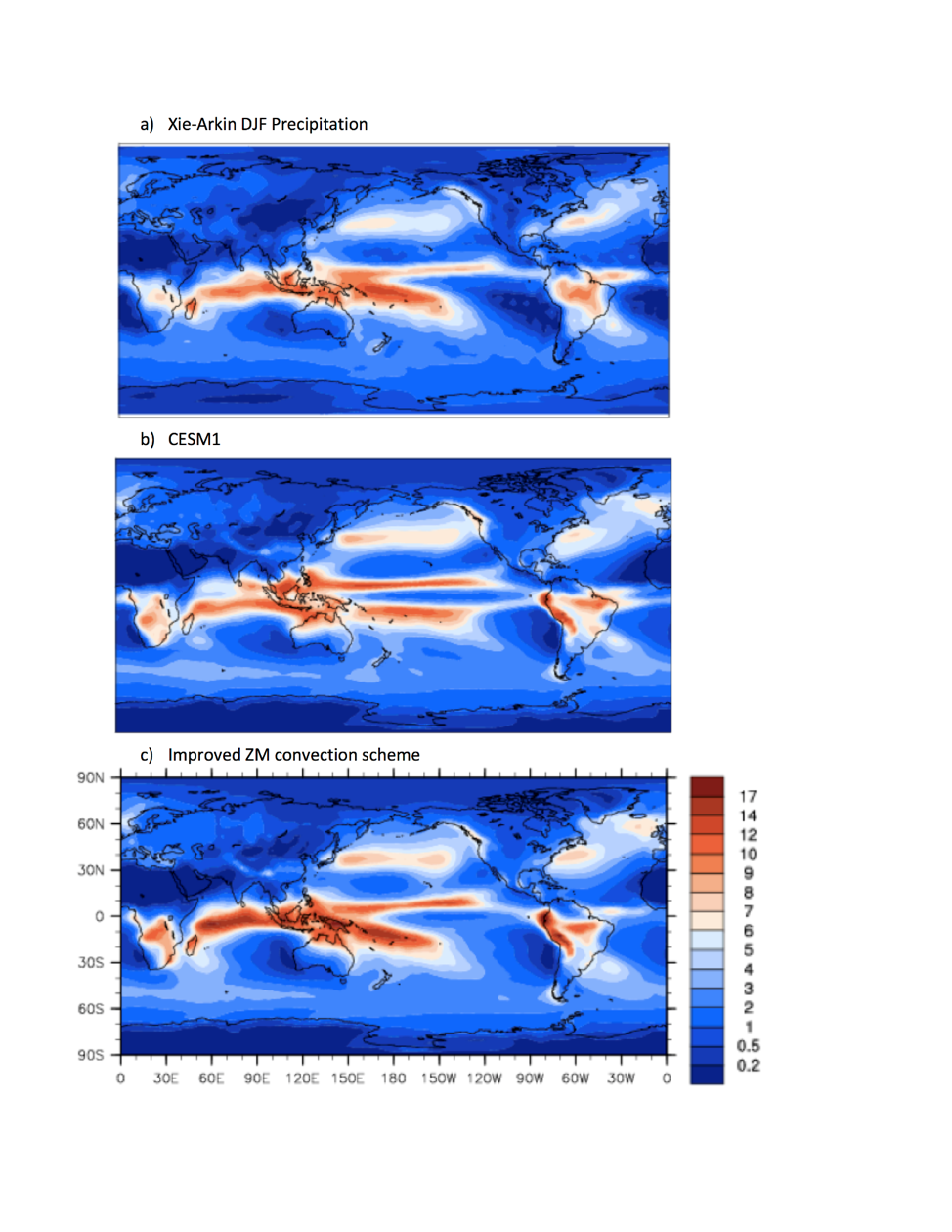Trace the path of a master modeler, who weaves into math the dynamic motion, pressure, heat, and moisture behind storm clouds

Among other things, Zhang studies convection dynamics, the intricate interplay of motion, pressure, thermal disturbances, and moisture that cause the buoyant rise of what we call thunderclouds. From there Zhang investigates how convection is represented in general circulation models. To date, he says, many of the biases in such models come from scant understanding of the dynamics of convection.
Part of the reason for that knowledge gap, says Zhang, is that “convection is a very complex process, it involves many physical interactions, and it can be very expensive to measure.”
If you move in certain circles, you know his name already, as one half of the famous Zhang-McFarlane scheme for parameterizing cumulous convection. The scheme was launched in a landmark Atmosphere-Ocean paper published in 1995.
By then, Zhang had already been at Scripps for three years, but the work was done while he was still in a two-year post-doctoral fellowship at The Canadian Centre for Climate Modeling and Analysis, where he met mentor and co-author Norman A. McFarlane.
The scheme, simpler than previous concepts, was tested first in a Canadian model. Then in 1996 Zhang-McFarlane was incorporated into what at the time was the Community Climate Model, or CCM, of the National Center for Atmospheric Research in Boulder, Colorado. The CCM, renamed the Community Atmosphere Model (CAM), has so far lasted six generations with only minor changes. (That number includes a next generation to be released soon.)
In all, Zhang attributes the Zhang-McFarlane scheme’s longevity to its realistic physics and the fact that it is economical to use.
The scheme that bears his name is also used in the new Accelerated Climate Model for Energy (ACME), which is going to be known as the Energy Exascale Earth System Model (E3SM), the primary earth system model developed by the U.S. Department of Energy (DOE).
Improving Such Schemes through ASR

In recent years, Zhang has done work to improve the convection parameterization scheme that bears his name. He just wrapped up one such project for the DOE’s Atmospheric System Research (ASR) program, where the overarching goal is to reduce uncertainty in regional and global climate simulations.
Done with Scripps co-investigator Xiaoliang Song, the 2012 to 2015 ASR project used observational data from the DOE’s Atmospheric Radiation Measurement (ARM) Facility to evaluate and improve convective parameterizations for global circulation models.
There were two main objectives: to develop a convective microphysics scheme for CAM5 (already being used by researchers, Zhang says) and to improve the understanding of convective trigger functions. These are the large-scale atmospheric and thermodynamic conditions under which convection—that upwelling of deep clouds—starts to develop.
The first objective of the Zhang-Song ASR project was designed to address the scarcity of work done previously on the details of microphysics within convection.
The second objective was designed to correct a common bias in most models regarding convective triggers—that they happen frequently. “In models, convection is hyperactive,” says Zhang, and models also get the timing wrong.
ARM measurements, he adds, “provided a more sound physical basis for improving” our sense of convective triggers.
So far this 2012 to 2015 project has generated 17 peer-reviewed papers, says Zhang.
However, the work of a convection modeler is never done. Zhang just finished a progress report in June on a second ASR project underway. Started last year, it is designed to improve convection and cloud parameterization in the CAM5 model by using ARM observations.
One point is to further improve trigger function for convection as it relates to circulation conditions, he says. Another is to look at convection through the lens of what atmospheric scientists call “scale awareness.” Convection schemes have to be able to adjust to scale changes as grid spacing gets smaller and smaller in models.
Preliminary results show that current convection parameterization schemes do not have scale awareness, says Zhang, including Zhang-McFarlane. To make and test adjustments, he adds, “ARM data help. Observations can be used to guide us at coarse resolution scales of 100 kilometers or so.”
There is a third objective to the current ASR projects, says Zhang: to investigate the interaction of convection microphysics with aerosols associated with pollution. That is, to ask how pollution affects convection development.
The results are mixed so far. Polluted air can either “invigorate or suppress” convection, he says, depending on humidity, wind shear, and other factors.
But at any rate, current models do not account for the microphysics of polluted air in convection, says Zhang, and his current ASR work will fill in some of those knowledge gaps for the first time.
The Hoe, and Holding onto Hope

Experts in convection parameterization know Zhang’s name in its famous Zhang-McFarlane iteration. But they might not know that he graduated from high school at age 15 during the waning years of the Cultural Revolution in China.
He then spent two years as a farmer “with no hope of receiving a college education,” he says. “I was thinking that I would spend the rest of my life digging dirt. That was horrifying.”
Two years wielding a hoe did nothing to shake the twin passions that still motivate him today. On the farm, says Zhang, “I was the math and physics guy.”
By age 17, he was at the Nanjing Institute of Meteorology, where a temptation to concentrate on math did not last long. Zhang discovered that meteorology required both his passions: physics to understand the forces behind weather and math to describe and quantify them.
Armed with a bachelor’s degree and a Chinese government fellowship, Zhang considered three offers from Canadian universities: Alberta, Toronto, and McGill. Drawn to working with Professor of Physics Han-Ru Cho, Zhang made his way to Toronto, where Cho offered him two paths of study: convection dynamics or the genesis of midlatitude cyclones.
“It was an easy choice,” says Zhang, who was already enamored of the challenge of the convection puzzle. He went on to earn an M.S. degree in 1985 and a Ph.D. in atmospheric physics in 1989.
For his doctoral dissertation, Zhang grappled with what was then one of the most difficult areas of convection studies and a real test of both his physics and math: how to parameterize (represent) momentum transfer by convection.
As a postdoc with McFarlane, he tried to incorporate that Ph.D. work into a Canadian model, which led to the realization that a bigger problem was at hand: parameterizing cumulous convection itself. And so a famous scheme was born.
Zhang was asked to imagine going back to 1975, and talk to that boy of 15, who had just moved from doing math and physics to farming rice and vegetables.
“I would say, follow your heart,” he says. “That pretty much sums up my career trajectory. I had several opportunities to move in a different direction and in the end I decided to do what I am doing.”
# # #
This work was supported by the U.S. Department of Energy’s Office of Science, Office of Biological and Environmental Research as part of the Atmospheric System Research Program.

